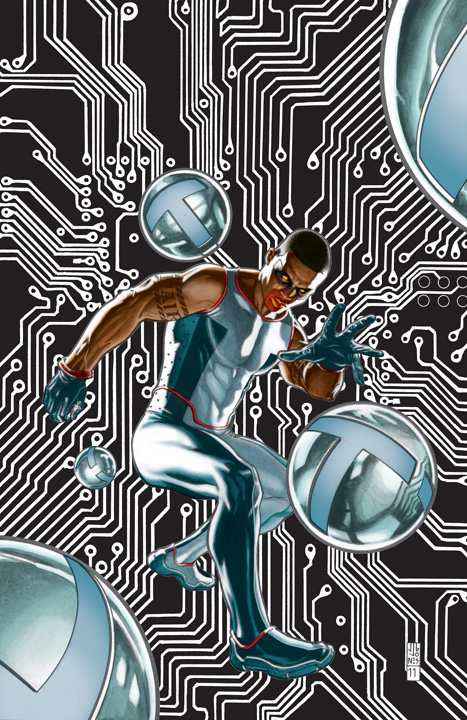Each weekday, Tim will take a look at what we know about each of the upcoming 52 new comics from the September DC relaunch, one series at a time. Today: MISTER TERRIFIC!
The Concept and Characters: Mister Terrific, the world’s third smartest man. That’s not too shabby on a planet with Lex Luthor and Batman running around. This new Mister Terrific series doesn’t involve a relaunch or a streamlining of decades of continuity, unlike so many other September DC comics. This is a straight-up launch. A brand new solo series featuring Michael Holt, black-belt decathlete super-genius and his flying T-spheres.
Mr. Terrific, as a character, has been around nearly as long as the superhero genre, starting in the Golden Age with Sensation Comics #1 from 1942, sporting his green and red costume with “Fair Play” written across his belly. Such an “aw, shucks, I’m a good guy” kind of superhero didn’t have much life after the 1950s, and the identity lay dormant for a couple of generations, until John Ostrander and Tom Mandrake revived the concept as the inspiration for a new character in a 1997 issue of The Spectre. This would be a new Mr. Terrific, one who was edgier, more in tune with modern sensibilities. You could tell, because he had “Fair Play” written on the sleeves of his leather jacket. Dangerous!
That new, edgier version – the Michael Holt incarnation – became an integral part of the long-running JSA series of the 2000’s, most notably written by Geoff Johns. You might say that Mr. Terrific was the breakout star of that series, only he never broke out quite enough to merit his own solo book. Instead, Johns used him when he could, and the characacter became part of the DC tapestry, playing a prominent role in the international espionage Checkmate agency, and making guest appearances in various super-titles over the years.
But now here he is, in a book devoted to his heroic, fairly-played exploits, using his action hero brawn and his brains to win the day. And this time, he sports a “Fair Play” tattoo, because, as a solo hero, he’s got to be at least 15% edgier.
The Creative Team: Though my description above expresses more than a little mockery for some of the accoutrements of his costume, Michael Holt is a character who would make a stellar lead character. He could be played as a less tormented Batman type, always five steps ahead of the criminals. Someone who would be perfectly suited for street-level fisticuffs and sci-fi adventure and everything in between. Plus, as one of the few non-white leading characters in the DCU, giving him a spotlight book helps to provide at least a sense of diversity within the superhero set.
The creative team isn’t a great selling point, though. As a writer, you have Eric Wallace, who seems well-credentialed for the job on paper. He has more-than-respectable television credits, and he’s been entrenched in the DC Universe for the past two years, most notably as the writer of the grown-up-Teen-Titans series, called, simply, Titans. But his work hasn’t been impressive. He’s a middling superhero writer at this point in his career, with a tendency towards excessive melodrama at the expense of clever plotting or effective character work.
And what he has said about some aspects of the Mister Terrific series doesn’t instill much confidence in his ability to break out of that rut: “…exploring Michael’s love life was one of the things I wanted to do most with this book,” Wallace says. “I mean, come on. Imagine an episode of The Bachelor where the star isn’t just rich and attractive, but he’s also a bona fide superhero. It’s irresistible from a storytelling point-of-view.”
Irresistible? That’s one way of putting it. Another way of putting it is… well, that just sounds terrible.
Joining Wallace on the series is artist Roger Robinson, a veteran who has done plenty of work over the past two decades but hasn’t had a shot at a big series. He’s the guy who always draws the fourth-tier books, like Spider-Man 2099. Or Azrael. Or The Web. He’s a decent enough artist, and he’ll surely do nice work on the series. But what’s troubling is that he’s not drawing issue #2. He’s been replaced by Gianluca Gugliotta, an artist with very few credits to his name. Gugliotta is about the equivalent of Robinson, ability-wise, but with two different artists in two issues, this Mister Terrific series isn’t starting with a confident foot forward.
Recommendation: Skip it. Wallace has yet to prove that his comics have any bite to them, and though neither Robinson nor Gugliotta are weak artists, they aren’t strong enough visually to make the book more interesting than its script. As one of the few DC comics in September that spotlights a lesser-known character, it’s easy to want to root for its survival, but this creative team isn’t likely to sustain much interest in the character or his world.
Tim Callahan writes about comics for Tor.com, Comic Book Resources, Back Issue magazine, and his own Geniusboy Firemelon blog.










